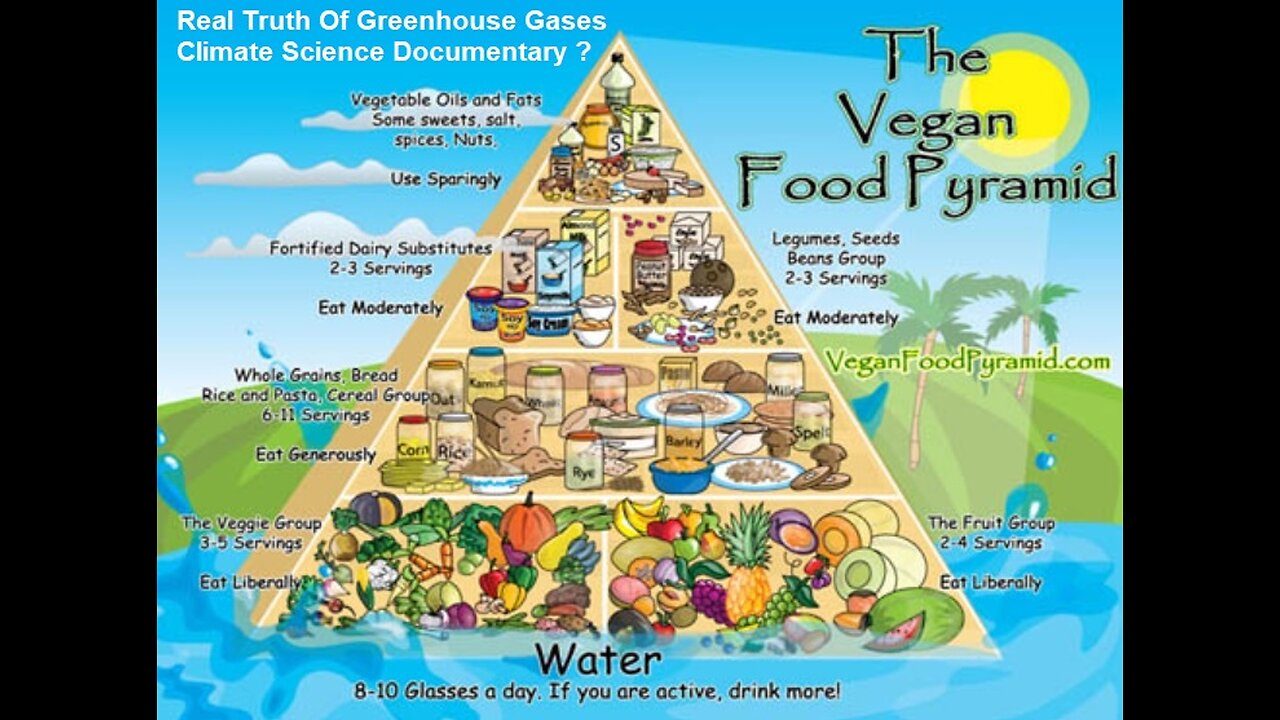Premium Only Content

O.K. Who Farted? LOL Real Truth Of Greenhouse Gases Climate Science Documentary
We live in the world where sex is free and love costs, where losing a phone is scarier than losing morale, where it is fashionable to get drunk and using drugs, because if you don’t do that, you’re old and out, where men cheat on their wives with girls and if they don’t, it’s for fear of being caught, where girls are more afraid of being pregnant than getting AIDS, where pizza delivery is faster than an ambulance, where clothes decide a person’s value and money is more important than friends and family... This is not my world. Where has my world gone? There are two components of flatulence that contribute to global warming: carbon dioxide and methane. Both are produced as a result of gut bacteria metabolizing complex carbohydrates (like fiber) that our upper digestive system is incapable of processing efficiently. There's a lot of diversity in the composition of the population of bacteria in people's guts; carbon dioxide producing bacteria are quite common, while methanogens (methane-producers) are pretty rare.
As farting habits are almost entirely dependent on diet and the composition of gut bacteria, it's very difficult to establish what a "standard" fart is like. Surprisingly, there have been a number of studies conducted to establish what the chemical composition of flatulence is, but I think the most useful one (being the connoisseur of fart articles that I am) is Investigation of normal flatus production in healthy volunteers. In this study, the authors analyzed the chemical composition of the farts of 10 volunteers when they were on a high fiber diet (normal diet supplemented with 200 grams of baked beans a day) and a no fiber diet.
The no fiber diet produced very little flatulence in the panel, while the high fiber diet produced varying amounts of both carbon dioxide and methane -- specifically, an average of 15 milliliters of methane a day, and a median of around 70 milliliters of carbon dioxide per day. That's about 10 milligrams of methane and 140 milligrams of carbon dioxide per day.
Assuming that these people and this diet are representative of the world population (not necessarily true, but close enough), human beings collectively release about 73 metric tons of methane and 1000 metric tons of carbon dioxide into the atmosphere every day just by farting.
This is a trivial amount of carbon dioxide -- roughly equivalent to 1000 people flying from New York to Los Angeles. Methane is about 20 times as potent of a greenhouse gas, so we can bump that up to 2000 people flying one way.
Forget cows, human farts I am pretty sure are what's roasting this god awful existence. Vegetarians fart at least 8 more times than meat eaters (that is a fact).
So the conclusion, stop wasting money on cows farting and give all those billions of dollars to the have nots of this world. We will end poverty and stop wasting our attention on things that don't matter, both at the same time
Global warming is a profit center and makes me want to vomit every time I see energy, attention and money being directed to it. How about if we spend all that money figuring out why we cant stop not getting along with each other. We seem to think learning how to do that after thousands of years of practice doesn't matter. Instead “let's waste time on what won't get better until we clean the closets on our own behavioral problems.” Boy, are we clueless!! I am not talking about rare mental disorders either. I am talking about the common sh*tting on each other in most arenas of society and calling it business and legalities. I am talking about our common behavior that passes as humane. We are in the absolute dumps in the way we treat each other. From the assholes in power and money all the way down to the alley ways. How pathetic our world is. Global warming is all money sh*t and almost nothing else. Put that in your pipe and smoke it!
Since increasing carbon dioxide in the atmosphere is causing global warming, then why the continued manufacture of Carbon Dioxide Fire Extinguisher and Carbonated Soft Drinks? Climate change deniers make many false claims about carbon dioxide and other greenhouse gases. These include the idea that CO2 has a limited or negligible impact on global warming—or even has the net effect of cooling our planet. Some also claim that the greenhouse effect would violate the laws of physics. Others make the assertion that the small quantities of greenhouse gases in the atmosphere couldn't possibly cause significant worldwide temperature changes. As I show here, every single one of these arguments are incorrect.
Assume the average American drinks 50 gallons of carbonated soft drinks each year and the U.S. population is 328 million people. That means about 16.4 billion gallons of soda is consumed every year in the United States. One gallon equals 3.78 liters, so U.S. annual consumption of carbonated soft drinks is 63 billion liters. Total annual carbon dioxide emissions is about 27.4 billion metric tons. Thus, 0.001 percent of all carbon dioxide emissions in the United States is contributed by carbonated soft drinks. These numbers are only rough approximations, but the inescapable conclusion is that carbon dioxide released into the atmosphere from soft drinks is inconsequential.
When Would It Be Dangerous to Use a Carbon Dioxide Fire Extinguisher?
Carbon dioxide fire extinguishers, when used in the right circumstances can save lives. However, it would be dangerous to use a carbon dioxide fire extinguisher when dealing with flammable gases, cooking oils and fats, or in a confined space.
The terms global warming and climate change are often used interchangeably, but the two phenomena are different.
Global warming is the rise in global mean temperature due to the rampant release of heat trapping gasses like carbon dioxide and methane. The atmosphere acts like a blanket that surrounds the earth. When we burn oil, coal, or natural gas for energy, the carbon dioxide released acts like thickening the blanket that envelops our planet. This disrupts the balance of incoming and outgoing solar radiation, and creates a warming system that cannot naturally repair itself in the span of the coming centuries. Based on surface and atmospheric temperatures from thousands of locations, and from satellites worldwide, scientists have determined that the global mean temperature has risen 0.8 degrees C (1.4 degrees F) since 1880. We know the carbon dioxide released from the fossil fuels that humans are burning is responsible for this change because its unique chemical signature matches that found in the carbon dioxide entering our atmosphere right now.
Climate change is a more general term that refers to changes in many climatic factors (such as temperature and precipitation) from the global to the local scale. These changes are happening at different rates and in different ways in response to global warming. As a large scale example, the United States has overall become wetter over the 20th century, while the Sahel region of central Africa has become drier. Locally, the timing and amount of rainfall is changing, which is generally resulting in less frequent but more severe storms. This could lead to increased hillside erosion and flooding, even as overall aridity continues to intensify in some areas. Furthermore, global warming and associated climate change is decreasing the Sierra snow pack and melting it sooner, causing water shortages across the state and increasing wildfire risk. In other words, the climate is becoming more extreme in response to global warming.
The greenhouse effect increases the temperature of the Earth by trapping heat in our atmosphere. This keeps the temperature of the Earth higher than it would be if direct heating by the Sun was the only source of warming. When sunlight reaches the surface of the Earth, some of it is absorbed which warms the ground and some bounces back to space as heat. Greenhouse gases that are in the atmosphere absorb and then redirect some of this heat back towards the Earth.
The greenhouse effect is a major factor in keeping the Earth warm because it keeps some of the planet's heat that would otherwise escape from the atmosphere out to space. In fact, without the greenhouse effect the Earth's average global temperature would be much colder and life on Earth as we know it would not be possible. The difference between the Earth's actual average temperature 14° C (57.2° F) and the expected effective temperature just with the Sun's radiation -19° C (-2.2° F) gives us the strength of the greenhouse effect, which is 33° C.
The greenhouse effect is a natural process that is millions of years old. It plays a critical role in regulating the overall temperature of the Earth. The greenhouse effect was first discovered by Joseph Fourier in 1827, experimentally verified by John Tyndall in 1861, and quantified by Svante Arrhenius in 1896.
How does the greenhouse effect work?
To understand exactly how the greenhouse effect works, imagine the following: a warm, sunny day where the sun shines bright on the Earth. This sunlight (shortwave radiation) passes into the planet's atmosphere and warms the Earth. Part of this energy is absorbed by the Earth's surface, transformed into heat (longwave radiation) and radiated back towards space. But as this heat goes up through the atmosphere, some of it is trapped by the different greenhouse gases and doesn't escape into space. This in turn warms up the Earth's atmosphere; just like the windows of a greenhouse that lets light in and keeps the heat within to warm the plants growing inside.
The greenhouse effect: As heat goes up through the Earth's atmosphere, some of it is trapped by the different greenhouse gases. This in turn warms up the Earth's atmosphere; just like the windows of a greenhouse that lets light in and keeps the heat within to warm the plants growing inside.
Since some of the heat can't escape into space, it continues to add up which then warms up the Earth. This is what we call the greenhouse effect. So the more greenhouse gases you have in the atmosphere, the more heat stays on Earth.
If the amount of energy from the sun and the amount of greenhouse gases in the atmosphere remain the same, then the average temperature on Earth will also be constant. But this is no longer the case. The amount of greenhouse gases in our atmosphere is the highest it has been in the last 3 million years. This is enhancing the greenhouse effect and making the Earth warmer than normal, which is affecting the planet's weather patterns, creating global warming and climate change.
An everyday example of the greenhouse effect
If you open the door of a car that has been left parked in the sun for a couple of hours, you'll notice that the temperature inside the car is much warmer than the temperature outside. This is because the windows of the car allow the sunlight to enter. This light, once inside, is then partially converted into heat. However, these same windows do not allow the heat inside the car to pass through as easily as light, so some of this heat accumulates. The net effect is that more heat remains in than can come out, increasing the temperature inside the car.
What causes the greenhouse effect?
The greenhouse effect is caused by the interaction of the sun's energy with greenhouse gases such as carbon dioxide, methane, nitrous oxide and fluorinated gases in the Earth's atmosphere. The ability of these gases to trap heat is what causes the greenhouse effect.
Greenhouse gases are made of three or more atoms. This molecular structure makes it possible for these gases to trap heat in the atmosphere and then re-emit it towards the surface which further warms the Earth. This continuous cycle of trapping heat leads to an overall increase in global temperatures. This process, which is very similar to the way a greenhouse works, is why the gases that can produce this effect are collectively known as greenhouse gases.
The principal forcing gases of the greenhouse effect are:
Carbon dioxide (CO2) - Methane (CH4) - Nitrous oxide (N2O) - Fluorinated gases
The main feedback gas of the greenhouse effect is:
Water vapor
Carbon dioxide, methane, nitrous oxide and the fluorinated gases are all well-mixed gases in the atmosphere that do not react to changes in temperature and air pressure, so the levels of these gases are not affected by condensation. Water vapor on the other hand, is a highly active component of the climate system that responds rapidly to changes in conditions by either condensing into rain or snow, or evaporating to return to the atmosphere. Thus the impact of the greenhouse effect is primarily circulated through water vapor, and it acts as a fast feedback.
Carbon dioxide and the other non-condensing greenhouse gases are the key gases within the Earth's atmosphere that sustain the greenhouse effect and control its strength. Water vapor is a fast-acting feedback but its atmospheric concentration is controlled by the radiative forcing supplied by the non-condensing greenhouse gases.
In fact, the greenhouse effect would collapse were it not for the presence of carbon dioxide and the other non-condensing greenhouse gases. Together the feedback by the condensing and the forcing by the non-condensing gases within the atmosphere both play an important role in the greenhouse effect.
Main sources of carbon dioxide emissions There are both natural and human sources of carbon dioxide emissions. Natural sources include decomposition, ocean release and respiration. Human sources come from activities like cement production, deforestation as well as the burning of fossil fuels like coal, oil and natural gas.
Due to human activities, the atmospheric concentration of carbon dioxide has been rising extensively since the Industrial Revolution and has now reached dangerous levels not seen in the last 3 million years. Human sources of carbon dioxide emissions are much smaller than natural emissions but they have upset the natural balance that existed for many thousands of years before the influence of humans.
This is because natural sinks remove around the same quantity of carbon dioxide from the atmosphere than are produced by natural sources.4 This had kept carbon dioxide levels balanced and in a safe range. But human sources of emissions have upset the natural balance by adding extra carbon dioxide to the atmosphere without removing any.
Carbon Dioxide Emissions: Human Sources
Since the Industrial Revolution, human sources of carbon dioxide emissions have been growing. Human activities such as the burning of oil, coal and gas, as well as deforestation are the primary cause of the increased carbon dioxide concentrations in the atmosphere.
87 percent of all human-produced carbon dioxide emissions come from the burning of fossil fuels like coal, natural gas and oil. The remainder results from the clearing of forests and other land use changes (9%), as well as some industrial processes such as cement manufacturing (4%).
Human sources of carbon dioxide emissions, IEA. Almost all human carbon dioxide emissions come from the combustion of fossil fuels.
Source: Le Quéré, C. et al. (2013). The global carbon budget 1959-2011.
Fossil fuel combustion/use
The largest human source of carbon dioxide emissions is from the combustion of fossil fuels. This produces 87% of human carbon dioxide emissions. Burning these fuels releases energy which is most commonly turned into heat, electricity or power for transportation. Some examples of where they are used are in power plants, cars, planes and industrial facilities. In 2011, fossil fuel use created 33.2 billion tones of carbon dioxide emissions worldwide.
The 3 types of fossil fuels that are used the most are coal, natural gas and oil. Coal is responsible for 43% of carbon dioxide emissions from fuel combustion, 36% is produced by oil and 20% from natural gas.5
Coal is the most carbon intensive fossil fuel. For every tones of coal burned, approximately 2.5 tones of CO2e are produced.6 Of all the different types of fossil fuels, coal produces the most carbon dioxide. Because of this and it's high rate of use, coal is the largest fossil fuel source of carbon dioxide emissions. Coal represents one-third of fossil fuels' share of world total primary energy supply but is responsible for 43% of carbon dioxide emissions from fossil fuel use.
Anything involving fossil fuels has a carbon dioxide emission ticket attached. So for example, burning these fuels releases energy but carbon dioxide also gets produced as a byproduct. This is because almost all the carbon that is stored in fossil fuels gets transformed to carbon dioxide during this process.
The three main economic sectors that use fossil fuels are: electricity/heat, transportation and industry. The first two sectors, electricity/heat and transportation, produced nearly two-thirds of global carbon dioxide emissions in 2010.
Electricity/Heat sector
Electricity and heat generation is the economic sector that produces the largest amount of man-made carbon dioxide emissions. This sector produced 41% of fossil fuel related carbon dioxide emissions in 2010. Around the world, this sector relies heavily on coal, the most carbon-intensive of fossil fuels, explaining this sector giant carbon footprint.
Almost all industrialized nations get the majority of their electricity from the combustion of fossil fuels (around 60-90%). Only Canada and France are the exception. Depending on the energy mix of your local power company you probably will find that the electricity that you use at home and at work has a considerable impact on greenhouse gas emissions.
Below is a chart for percentage of electrical energy produced by fossil fuel combustion for major industrialized nations, for the complete list of all nations click here.
The industrial, residential and commercial sectors are the main users of electricity covering 92% of usage. Industry is the largest consumer of the three because certain manufacturing processes are very energy intensive. Specifically, the production of chemicals, iron/steel, cement, aluminum as well as pulp and paper account for the great majority of industrial electricity use. The residential and commercial sectors are also heavily reliant on electricity for meeting their energy needs, particularly for lighting, heating, air conditioning and appliances.
Transportation sector
The transportation sector is the second largest source of anthropogenic carbon dioxide emissions. Transporting goods and people around the world produced 22% of fossil fuel related carbon dioxide emissions in 2010.5 This sector is very energy intensive and it uses petroleum based fuels (gasoline, diesel, kerosene, etc.) almost exclusively to meet those needs. Since the 1990s, transport related emissions have grown rapidly, increasing by 45% in less than 2 decades.
Road transport accounts for 72% of this sector's carbon dioxide emissions.5 Automobiles, freight and light-duty trucks are the main sources of emissions for the whole transport sector and emissions from these three have steadily grown since 1990. Apart from road vehicles, the other important sources of emissions for this sector are marine shipping and global aviation.
Marine shipping produces 14% of all transport carbon dioxide emissions. While there are a lot less ships than road vehicles used in the transportation sector, ships burn the dirtiest fuel on the market, a fuel that is so unrefined that it can be solid enough to be walked across at room temperature.9 Because of this, marine shipping is responsible for over 1 billion tones of carbon dioxide emissions.10 This is more than the annual emissions of several industrialized countries (Germany, South Korea, Canada, UK, etc.) and this sector continues to grow rapidly.
Global aviation accounts for 11% of all transport carbon dioxide emissions. International flights create about 62% of these emissions with domestic flights representing the remaining 38%.11 Over the last 10 years, aviation has been one of the fastest growing sources of carbon dioxide emissions.12 Aviation is also the most carbon-intensive form of transportation, so it's growth comes with a heavy impact on climate change.
Sources of Carbon Dioxide emissions from fossil fuel combustion, IEA. The three main sectors that use fossil fuels are: Utilities (power, gas, oil etc...), Transportation and Industrial production.
Source: CO2 Emissions from Fuel Combustion (2012), International Energy Agency.
highlights one of the most alarming trends in today's modern economy. Emissions caused by the transportation of people and goods has grown so rapidly that it has surpassed emissions from the industrial sector, which has had a huge impact on climate change. This trend started in the 1990's and has continued ever since causing an increase in indirect emissions.
The emissions caused by the transportation of goods are examples of indirect emissions since the consumer has no direct control of the distance between the factory and the store. The emissions caused by people traveling (by car, plane, train, etc...) are examples of direct emissions since people can chose where they are going and by what method.
Since the distance traveled by goods during production is continuing to grow, this is putting more pressure on the transportation industry to bridge the gap and ends up creating more indirect emissions. What's worse is that 99% of the carbon dioxide emissions caused by transportation of people and goods all over the world comes from the combustion of fossil fuels.
Industrial sector
The industrial sector is the third largest source of man-made carbon dioxide emissions. This sector produced 20% of fossil fuel related carbon dioxide emissions in 2010.5 The industrial sector consists of manufacturing, construction, mining, and agriculture. Manufacturing is the largest of the 4 and can be broken down into 5 main categories: paper, food, petroleum refineries, chemicals, and metal/mineral products. These categories account for the vast majority of the fossil fuel use and CO2 emissions by this sector.
Manufacturing and industrial processes all combine to produce large amounts of each type of greenhouse gas but specifically large amounts of CO2. This is because many manufacturing facilities directly use fossil fuels to create heat and steam needed at various stages of production. For example factories in the cement industry, have to heat up limestone to 1450°C to turn it into cement, which is done by burning fossil fuels to create the required heat.
Land use changes
Land use changes are a substantial source of carbon dioxide emissions globally, accounting for 9% of human carbon dioxide emissions and contributed 3.3 billion tones of carbon dioxide emissions in 2011.1 Land use changes are when the natural environment is converted into areas for human use like agricultural land or settlements. From 1850 to 2000, land use and land use change released an estimated 396-690 billion tones of carbon dioxide to the atmosphere, or about 28-40% of total anthropogenic carbon dioxide emissions.13
Deforestation has been responsible for the great majority of these emissions. Deforestation is the permanent removal of standing forests and is the most important type of land use change because its impact on greenhouse gas emissions. Forests in many areas have been cleared for timber or burned for conversion to farms and pastures. When forested land is cleared, large quantities of greenhouse gases are released and this ends up increasing carbon dioxide levels in three different ways.
Trees act as a carbon sink. They remove carbon dioxide from the atmosphere via photosynthesis. When forests are cleared to create farms or pastures, trees are cut down and either burnt or left to rot, which adds carbon dioxide to the atmosphere.
Since deforestation reduces the amount of trees, this also reduces how much carbon dioxide can be removed by the Earth's forests. When deforestation is done to create new agricultural land, the crops that replace the trees also act as a carbon sink, but they are not as effective as forests. When trees are cut for lumber the wood is kept which locks the carbon in it but the carbon sink provided by forests is reduced because of the loss of trees.
Deforestation also causes serious changes in how carbon is stored in the soil. When forested land is cleared, soil disturbance and increased rates of decomposition in converted soils both create carbon dioxide emissions. This also increases soil erosion and nutrient leaching which further reduces the area's ability to act as a carbon sink.
Industrial processes
There are many industrial processes that produce significant amounts of carbon dioxide emissions as a by product of chemical reactions needed in their production process. Industrial processes account for 4% of human carbon dioxide emissions and contributed 1.7 billion tones of carbon dioxide emissions in 2011.
Many industrial processes emit carbon dioxide directly through fossil fuel combustion as well indirectly through the use of electricity that is generated using fossil fuels. But there are four main types of industrial process that are a significant source of carbon dioxide emissions: the production and consumption of mineral products such as cement, the production of metals such as iron and steel, as well as the production of chemicals and petrochemical products.
Cement production produces the most amount of carbon dioxide amongst all industrial processes. To create the main ingredient in cement, calcium oxide, limestone is chemically transformed by heating it to very high temperatures. This process produces large quantities of carbon dioxide as a byproduct of the chemical reaction. So much so that making 1000 kg of cement produces nearly 900 kg of carbon dioxide.
Steel production is another industrial process that is an important source of carbon dioxide emissions. To create steel, iron is melted and refined to lower its carbon content. This process uses oxygen to combine with the carbon in iron which creates carbon dioxide. On average, 1.9 tones of CO2 are emitted for every tones of steel produced.
Fossil fuels are used to create chemicals and petrochemical products which leads to carbon dioxide emissions. The industrial production of ammonia and hydrogen most often use natural gas or other fossil fuels as a starting base, creating carbon dioxide in the process. Petrochemical products like plastics, solvents, and lubricants are created using petroleum. These products evaporate, dissolve, or wear out over time releasing even more carbon dioxide during the product's life.
Carbon Dioxide Emissions: Natural Sources
Apart from being created by human activities, carbon dioxide is also released into the atmosphere by natural processes. The Earth's oceans, soil, plants, animals and volcanoes are all natural sources of carbon dioxide emissions.
Human sources of carbon dioxide are much smaller than natural emissions but they upset the balance in the carbon cycle that existed before the Industrial Revolution. The amount of carbon dioxide produced by natural sources is completely offset by natural carbon sinks and has been for thousands of years. Before the influence of humans, carbon dioxide levels were quite steady because of this natural balance.
42.84 percent of all naturally produced carbon dioxide emissions come from ocean-atmosphere exchange. Other important natural sources include plant and animal respiration (28.56%) as well as soil respiration and decomposition (28.56%).4 16 A minor amount is also created by volcanic eruptions (0.03%).
The Earth's oceans, soil, plants, animals and volcanoes are all natural sources of carbon dioxide emissions.
Source: IPCC Fourth Assessment Report: Climate Change 2007, Intergovernmental Panel on Climate Change.
Ocean-atmosphere exchange
The largest natural source of carbon dioxide emissions is from ocean-atmosphere exchange. This produces 42.84% of natural carbon dioxide emissions. The oceans contain dissolved carbon dioxide, which is released into the air at the sea surface. Annually this process creates about 330 billion tones of carbon dioxide emissions.
Many molecules move between the ocean and the atmosphere through the process of diffusion, carbon dioxide is one of them. This movement is in both directions, so the oceans release carbon dioxide but they also absorb it. The effects of this movement can be seen quite easily, when water is left to sit in a glass for long enough, gases will be released and create air bubbles. Carbon dioxide is amongst the gases that are in the air bubbles.
Plant and animal respiration
An important natural source of carbon dioxide is plant and animal respiration, which accounts for 28.56% of natural emissions. Carbon dioxide is a byproduct of the chemical reaction that plants and animals use to produce the energy they need. Annually this process creates about 220 billion tones of carbon dioxide emissions.
Plants and animals use respiration to produce energy, which is used to fuel basic activities like movement and growth. The process uses oxygen to break down nutrients like sugars, proteins and fats. This releases energy that can be used by the organism but also creates water and carbon dioxide as byproducts.
Soil respiration and decomposition
Another important natural source of carbon dioxide is soil respiration and decomposition, which accounts for 28.56% of natural emissions. Many organisms that live in the Earth's soil use respiration to produce energy. Amongst them are decomposers who break down dead organic material. Both of these processes releases carbon dioxide as a byproduct. Annually these soil organisms create about 220 billion tones of carbon dioxide emissions.
Any respiration that occurs below-ground is considered soil respiration. Plant roots, bacteria, fungi and soil animals use respiration to create the energy they need to survive but this also produces carbon dioxide. Decomposers that work underground breaking down organic matter (like dead trees, leaves and animals) are also included in this. Carbon dioxide is regularly released during decomposition.
Volcanic eruptions
A minor amount carbon dioxide is created by volcanic eruptions, which accounts for 0.03% of natural emissions. Volcanic eruptions release magma, ash, dust and gases from deep below the Earth's surface. One of the gases released is carbon dioxide. Annually this process creates about 0.15 to 0.26 billion tones of carbon dioxide emissions.
The most common volcanic gases are water vapor, carbon dioxide, and sulfur dioxide. Volcanic activity will cause magma to absorb these gases, while passing through the Earth's mantle and crust. During eruptions, the gases are then released into the atmosphere.
Main sources of methane emissions There are both natural and human sources of methane emissions. The main natural sources include wetlands, termites and the oceans. Natural sources create 36% of methane emissions. Human sources include landfills and livestock farming. But the most important source being the production, transportation and use of fossil fuels. Human-related sources create the majority of methane emissions, accounting for 64% of the total.
Methane levels have more than doubled over the last 150 years. This is because of human activities like fossil fuel use and intensive farming. Before the Industrial Revolution, natural sinks kept methane levels in a safe range.
Humans are creating methane emissions a lot faster than the Earth can remove them. Which has increased global methane levels. During the last 800,000 years, methane concentrations have always varied between 350-800 ppb. Since the Industrial Revolution, methane levels have become much higher. So much so that they are now 2.5 times larger.
Methane Emissions: Human Sources
Since the Industrial Revolution, human sources of methane emissions have been growing. Fossil fuel production and intensive livestock farming have caused the current increase methane levels. Together these two sources are responsible for 60% of all human methane emissions. Other sources include landfills and waste (16%), biomass burning (11%), rice agriculture (9%) as well as biofuels (4%).
Human-related sources create the majority of total methane emissions, the 3 main sources are: fossil fuel mining/distribution, livestock farming and landfills.
Source: Bousquet, P. et al. (2006). Contribution of anthropogenic and natural sources to atmospheric methane variability.
Fossil fuel production, distribution and use
The largest human source is from the production, distribution and combustion of fossil fuels. This creates 33% of human methane emissions.
Methane emissions get produced wherever there are fossil fuels. It gets released whenever fossil fuels get extracted from the earth. Whether it is natural gas (which is in most part methane), coal or petroleum. More methane gets released during any type of handling, transportation (pipeline, truck delivery, etc.) or refinement of fossil fuels. Finally some methane is also produced during fossil fuel combustion.
By using fossil fuels, you contribute to the most important source of methane emissions. Fossil fuel production, distribution and use creates 110 million tones of methane per year.
A large part of methane emissions get caused by natural gas. Methane is the main component of natural gas. So leakage throughout this industry releases methane straight into the atmosphere. This includes the extraction, processing and transportation of natural gas.
Coal is another important source of methane emissions. In coal formation, pockets of methane get trapped around and within the rock. Coal mining related activities (extraction, crushing, distribution, etc.) release some of this trapped methane. Methane gets emitted from active underground and surface mines as well as abandoned ones.
Oil wells can also have methane deposits that get released during drilling and extraction. The refinement, transportation and storage of oil is also a source of methane emissions.
Incomplete combustion of fossil fuels also produces methane emissions. No combustion process is one hundred percent efficient. So when fossil fuels get used to make electricity, heat or power cars these all produce methane.
Livestock farming
An important source of methane emissions is from enteric fermentation in farm animals. This creates 27% of human methane emissions. Animals like cows, sheep and goats are examples of ruminant animals. During their normal digestion process they create large amounts of methane. Enteric fermentation occurs because of microorganisms in the stomach of these animals. This creates methane as a by-product that is either exhaled by the animal or released via flatus.
Because humans raise these animals for food, their emissions are human-related. This is why the meat that we eat everyday has a huge impact on total methane emissions. Livestock farming creates 90 million tones of methane per year.
Livestock related emissions has grown because of the large growth of livestock populations worldwide. Livestock production has seen large growth since the 1960s. With beef production more than doubling during this time.
Landfills and waste
Another important human source of methane emissions is from landfills and waste. Methane gets generated by the decomposition of solid waste in landfills. This also happens with animal and human waste streams. This accounts for 16% of human methane emissions. Landfills and waste produces 55 million tones of methane per year.
Landfills and open garbage dumps are full of organic matter. Our garbage contains things like food scraps, newspapers, cut grass and leaves. Every time new garbage comes in it gets pilled over the old garbage that was already there. The organic matter in our garbage gets trapped in conditions where there is no oxygen. This provides excellent conditions for methane producing microbes. They will break down the waste, which produces large amounts of methane emissions. Even after a landfill gets closed, bacteria will continue to decompose the buried waste. Which will emit methane for years.
Wastewater from domestic, municipal and industrial sources can also produce methane emissions. Wastewater can be either released, stored or sent for treatment to remove contaminants. As with landfills, if the decay of organic material in wastewater happens without oxygen then this will create methane.
Livestock farming at even a modest scale will have to manage large amounts of manure daily. This is usually managed by using large waste treatment systems and holding tanks. In many of these systems methane gets produced because they promote anaerobic conditions.
Biomass burning
Biomass burning causes a large amount of methane emissions. Biomass is material from living or dead organic matter. Incomplete burning of biomass creates methane emissions. Huge amounts can get produced during large scale burning. This creates 11% of human methane emissions.
Large open fires get used by humans to destroy crop waste and clear land for agricultural or other uses. Natural wildfires can contribute to this. But the great majority of biomass burning gets caused by human beings. Biomass burning creates 38 million tones of methane per year.
Rice agriculture
Another large human source of methane emissions is from rice agriculture. Paddy fields for rice production are man-made wetlands. They have high moisture content, are oxygen depletion and have ample organic material. This creates a great environment for methane producing microbes that decompose the organic matter.
Some of the methane produced gets absorbed by methane-consuming microorganisms. But the vast majority gets released into the atmosphere. Due to the swamp-like environment of rice fields, this crop creates 9% of human methane emissions. Rice agriculture creates 31 million tones of methane per year.
Biofuels
Each year biofuels produce 12 million tones of methane, making it a significant source. Any biomass used to produce energy for domestic or purposes counts as a biofuel. Incomplete biofuel combustion leads to the production of methane. This creates 4% of human methane emissions.
An estimated 80% of biofuels get used for domestic cooking, heating, and lighting. Often in open cooking fires burning wood, agricultural waste, or animal dung. This is the single largest contributor to global biofuel emissions.6 Almost half of the world's population, about 2.7 billion people, use solid biofuels to cook and heat their homes on a daily basis. Most are poor, and live in developing countries.
18% of biofuels get used by low technology enterprises such as brick or tile making kilns, restaurants, etc. The balance of the biofuels get consumed for transportation uses.
Methane Emissions: Natural Sources
Methane is also released into the atmosphere by natural processes. Wetlands, termites and the oceans are all natural sources of methane emissions.
The methane produced by natural sources is completely offset by natural methane sinks. This has been so for thousands of years. Before the influence of humans, methane levels were quite steady because of this natural balance. Today, human-related sources create the majority of total methane emissions. This has upset the natural balance that existed before the Industrial Revolution.
Wetlands are an important source of methane. They account for 78% of all natural emissions. Other natural methane sources include termites (12%) and the oceans (10%).
Wetlands are an important source of methane emissions, accounting for 78% of all naturally produced emissions. Other natural methane sources include termites (12%) and the oceans (10%).
Source: Bousquet, P. et al. (2006). Contribution of anthropogenic and natural sources to atmospheric methane variability.
Wetlands
Wetlands are the largest natural source of methane. This produces 78% of natural methane emissions. The water-logged conditions of wetlands are perfect for microbes. They need environments with no oxygen and abundant organic matter.
Part of wetland related emissions gets absorbed by methane-consuming microbes. But a large percentage escapes into the atmosphere. Wetlands create 147 million tones of methane each year.
Termites
Termites are a significant natural source of methane. During the normal digestion process of a termite, methane gets produced. Termites eat cellulose but rely on micro-organisms in their gut to digest it. These micro-organisms produce methane during the process. This creates 12% of natural methane emissions.
Each termite produces small amounts of methane on a daily basis. But when it gets multiplied by the world population of termites, their emissions add up. Creating a total of 23 million tones of methane per year.
Oceans
Another significant natural source of methane comes from the oceans. Methane producing microbes living in the ocean create these emissions. This creates 10% of natural methane emissions. Globally, oceans create 19 million tones of methane per year.
Oceanic methane emissions often gets produced in deeper sediment layers of productive coastal areas. This accounts for 75% of the oceans methane emissions. The methane created by these microbes mixes with the surrounding water. After some time it gets emitted to the atmosphere from the ocean surface.
Main sources of nitrous oxide emissions Nitrous oxide emissions gets produced by both natural and human sources. Important natural sources include soils under natural vegetation and the oceans. Natural sources create 62% of total emissions. Important human sources come from agriculture, fossil fuel combustion and industrial processes. Human-related sources are responsible for 38% of total emissions.
Human activities have added large quantities of reactive nitrogen compounds to the environment and have virtually doubled the mainly natural inputs existing at the beginning of the industrial age. But, a large part of this gets lost and cascades through the Earth's soils, water ways and atmosphere. This has increased nitrous oxide emissions by about 40-50% over pre-industrial levels.
Before the Industrial Revolution, the atmospheric concentration of nitrous oxide stayed in a safe range of levels because of natural sinks. But for a long time now human activities have been creating emissions much more rapidly than the Earth can remove them. Nitrous oxide levels are now higher today than at any other time during the last 800,000 years.
Nitrous Oxide Emissions: Human Sources
Since the Industrial Revolution, human sources of nitrous oxide emissions have been growing. Activities such as agriculture, fossil fuel combustion and industrial processes are the primary cause of the increased nitrous oxide concentrations in the atmosphere. Together these sources are responsible for 77% of all human nitrous oxide emissions. Other sources include biomass burning (10%), atmospheric deposition (9%) and human sewage (3%).
Almost all human-related nitrous oxide emissions come from the following 3 sources: artificial soil fertilization, mobile/stationary sources of fossil fuel combustion and livestock manure.
Source: IPCC Fourth Assessment Report: Climate Change 2007, Intergovernmental Panel on Climate Change.
Agriculture
The largest human source of nitrous oxide emissions is from agriculture which accounts for 67%. Agriculture creates both direct and indirect emissions. Direct emissions come from fertilized agricultural soils and livestock manure (42%). While indirect emissions come from runoff and leaching of fertilizers (25%). Agriculture creates 4.5 million tones of nitrous oxide per year.
Because of the inefficiencies of nitrogen uptake by plants and animals, only about 10 to 15% of reactive nitrogen ever enters a human mouth as food. The rest is lost to the environment. Industrialized farming practices have worsened this loss and the result has been increased emissions. Because of this, agriculture is the most important human source of nitrous oxide emissions.
Fertilized agricultural soils
The use of synthetic fertilizer for agriculture is a major source of nitrous oxide emissions. Fertilizers help feed plants by adding nitrogen directly to soils. But soil bacteria also take advantage of this extra nitrogen and use it to produce the energy they need to live and grow. Microbial processes of nitrification and denitrification produce nitrous oxide which is then released into the atmosphere. Similarly, the use of manure as a fertilizer also leads to emissions from agricultural soils. Nitrous oxide can be created rapidly when soils are warm and moist while also containing a ready supply of reactive nitrogen.
Synthetic fertilizers cause a heavy strain on the environment as well as on the quality of the food produced. These synthetic chemicals are absorbed by the plants which are then absorbed by us. Apart from this, large quantities of natural gas are used to make synthetic fertilizers because it is the main ingredient. The production process also takes a lot of energy so their impact on climate change is actually larger when we factor this in.
Livestock manure
The storage and handling of livestock manure is another direct source of agricultural nitrous oxide emissions. When the manure of livestock is not used as a fertilizer or left in fields during grazing, it has to be kept for treatment and disposal in animal waste management systems. Many of these systems create conditions that are favorable for nitrous oxide producing bacteria.
The same microbial processes responsible for generating nitrous oxide in soils, nitrification and denitrification, are also responsible for the nitrous oxide emitted when the nitrogen in manure decomposes. So places like poultry, beef and dairy farms produce significant amounts of nitrous oxide.
Intensive livestock farming systems have low nitrogen use efficiency, creating large amounts of losses. Only a small fraction of the ingested nitrogen in animal feed (about 5-30%) is retained in milk, meat, and eggs. The bulk part, 70-95%, is lost via animal waste.6 This extra nitrogen gets added to the environment and is causing increases in nitrous oxide emissions.
Runoff and leaching of fertilizers
Runoff and leaching of fertilizers from agricultural soils are an indirect source of nitrous oxide. Rainfall or irrigation water causes part of the reactive nitrogen in fertilizers to either leach into groundwater or be washed away to drainage ditches, eventually flowing into connecting rivers, estuaries and coastal zones.
This increases nitrogen levels in these areas, which microbes break down causing greater nitrous oxide emissions. Overuse of fertilizers or excessive rainfall often make the effects of runoff and leaching even worse.
Emissions of nitrous oxide from rivers, estuaries and coastal waters are generally considered as human-caused because most of the reactive nitrogen entering these ecosystems is associated with agricultural activities.
Fossil fuel combustion and industrial processes
Fossil fuel combustion and industrial processes are an important source of nitrous oxide emissions. These two combined are responsible for 10% of human emissions which equals 700,000 tones of nitrous oxide per year.
Nitrous oxide is a by-product of fuel combustion in mobile and stationary sources. When any fossil fuel is burnt, part of the nitrogen that is in the fuel and surrounding air gets oxidized creating nitrous oxide emissions. The majority of stationary emissions come from coal fired power plants. As for mobile emissions, almost all of it comes from cars and trucks that are used to transport people and goods.
Industrial processes also causes nitrous oxide emissions. The two main industrial sources are the production of nitric and adipic acid. Nitric acid is an important ingredient for synthetic fertilizers, while adipic acid is primarily used for making synthetic fibers. For both of these acids, oxidization of nitrogen compounds during the production process creates nitrous oxide.
Biomass burning
A substantial amount of nitrous oxide is caused by biomass burning, which accounts for 10% of human-caused emissions. Biomass burning is the burning of living and dead vegetation. In these fires, some of the nitrogen in the biomass and surrounding air is oxidized creating nitrous oxide emissions.
Large open fires are mainly used by humans to destroy crop waste and clear land for agricultural or other uses. While natural wildfires can contribute to this, the great majority of biomass burning is caused by human beings. This creates 700,000 tones of nitrous oxide per year.
Atmospheric deposition
Atmospheric deposition is another substantial human source of nitrous oxide emissions. Human activities release nitrogen compounds into the air which eventually falls back down to the Earth's surface. This provides ecosystems with an extra source of available nitrogen which stimulates nitrifying and denitrifying microbes causing increased emissions. This creates 9% of human-caused emissions.
Vapors from fertilizers and smoke from fossil fuel or biomass burning contain reactive nitrogen gases. These gases eventually fall out of the atmosphere because either rain washes them out or they get attached to dust and pollen that settle to the ground. Atmospheric deposition produces 700,000 tones of nitrous oxide per year.
Human sewage
As with animal waste, human waste is a significant source of nitrous oxide emissions. Sewage plants and septic tanks are used to store and treat wastewater. Many of these systems create conditions that are favorable for nitrous oxide producing bacteria. Human sewage produces 3% of human emissions.
Bacteria use nitrification and denitrification processes to break down the nitrogen-based organic materials that is found in human waste (urea, ammonia, and proteins). This creates 200,000 tones of nitrous oxide per year.
Nitrous Oxide Emissions: Natural Sources
Apart from being created by human activities, nitrous oxide is also released into the atmosphere by natural processes. The Earth's soil, oceans and atmosphere are all natural sources of nitrous oxide emissions.
Human sources of nitrous oxide are smaller than natural emissions but they upset the balance in the nitrogen cycle that existed before the Industrial Revolution. The quantity of nitrous oxide produced by natural sources is completely offset by natural sinks and has been for thousands of years. Before the influence of humans, nitrous oxide levels were quite steady because of this natural balance.
Soils under natural vegetation are an important source of nitrous oxide, accounting for 60% of all naturally produced emissions. Other natural sources include the oceans (35%) and atmospheric chemical reactions (5%).
Soils under natural vegetation are an important source of nitrous oxide, accounting for 60% of all naturally produced nitrous oxide emissions. Other natural sources include the oceans (35%) and atmospheric chemical reactions (5%).
Source: IPCC Fourth Assessment Report: Climate Change 2007, Intergovernmental Panel on Climate Change.
Soils under natural vegetation
The largest natural source of nitrous oxide is from soils under natural vegetation. This produces 60% of natural emissions. Uncultivated soils make up the majority of the Earth's land surface. So the nitrous oxide produced by microbes that break down nitrogen in these soils are considered natural sources.
Riparian and tropical rainforest soils are important contributors to this source because they have higher nutrient availability and moisture levels. This facilitates microbial nitrification and denitrification. Soils under natural vegetation create 6.6 million tones of nitrous oxide each year.
Oceans
An important natural source of nitrous oxide emissions comes from the oceans. Nitrous oxide producing microbes living in the ocean create these emissions. This produces 35% of natural emissions which equals 3.8 million tones of nitrous oxide per year.
Much of the nitrous oxide in the oceans arises from microbial activity in and around sinking particles, such as fecal pellets. These particles provide the anaerobic conditions necessary for denitrification, a process which creates nitrous oxide as a by-product.
Atmospheric chemical reactions
Chemical reactions in the atmosphere produce a significant amount of nitrous oxide emissions. The atmosphere acts as a source for nitrous oxide through the oxidation of ammonia which creates 5% of emissions.
Ammonia is a natural occurring gas in the atmosphere. The oceans, manure from wild animals as well as aging and rotting plants form the most important natural sources of ammonia in the air. The oxidization of ammonia from natural sources creates 600,000 tones of nitrous oxide per year.
Main sources of fluorinated gas emissions Fluorinated gases are used inside of products like refrigerators, air-conditioners, foams and aerosol cans. Emissions from these products are caused by gas leakage during the manufacturing process as well as throughout the product's life. Fluorinated gases are also used for the production of metals and semiconductors.
Emissions of the three main fluorinated gases (hydrofluorocarbons (HFCs), perfluorocarbons (PFCs) and Sulphur hexafluoride (SF6)) are almost all created by humans and are used mainly in industrial processes. With the exception of PFC-14 (CF4), fluorinated gases have no natural sources.
Human emissions have caused atmospheric levels to increase from near zero in 1750 to 89 parts per trillion (ppt) for HFCs and 6.7 ppt for SF6 in 2009. PFC levels have increased from 34.7 ppt in pre-industrial times to 82 ppt in 2009.1 2 For a long time now human activities have been creating fluorinated gas emissions much more rapidly than the Earth can remove them, increasing global levels.
The creation and/or use of refrigerators, air conditioning systems, foams as well as aerosols are the main source of fluorinated gas emissions.
Source: The 2010 Assessment of the Scientific Assessment Panel, UNEP.
Fluorinated gas emissions: HFCs
HFCs are the largest source of fluorinated gas emissions. They are also the fastest growing source of greenhouse gas emissions.3 Most HFCs are contained within equipment and products. Leakage of the gases causes emissions during manufacturing, maintenance as well as through regular usage. If disposal is not done properly, HFCs continue to leak out of the product until they are empty.
Refrigerators and air-conditioners are the most important source of HFC emissions. These devices use HFCs as a coolant, which leaks out slowly over time. Commercial refrigerators, like those used in supermarkets, release substantial amounts of HFCs with emission rates from 5%-22% per year.
Mobile air-conditioners (MAC) used in cars and other vehicles are the systems that are responsible for the largest amount of HFC emissions. This is a combination of there being a large amount of these devices installed in vehicles around the world (80% of passenger cars and commercial vehicles)5 and their high rate of coolant loss. The annual emission rate of MAC systems is approximately 8%, which leads to large refrigerant losses after 5 years of at least 40%.
Foams are a significant source of HFC emissions. These gases are used during the production of foams as blowing agents. HFCs create the tiny bubbles in foams but are then trapped inside the material, emissions can then be released at any point, from manufacturing to disposal.
HFC emissions are also produced by aerosols. HFCs are used as propellants in aerosol sprays to create a mist of liquid particles. So each time the spray is used, it also releases these gases directly into the atmosphere. Other smaller sources exist like fire protection and solvents.
HFC-134a, HFC-23, HFC-125 and HFC-152a account for the majority of HFC emissions. HFC-134a is used in refrigeration and air-conditioning with emissions equal to 149000 tones annually. HFC-23 is emitted as a byproduct during the production HCFC-22. HFC-23 emissions equal 8700 tones annually. HFC-125 is also used in refrigeration and air conditioning with emissions equal to 22000 tones annually. HFC-152a is used as a foam-blowing agent and in aerosol spray applications with emissions equal to 50000 tonnes annually.
Fluorinated gas emissions: PFCs
PFCs are a significant source of fluorinated gas emissions. These gases are created during the production processes of aluminum and semiconductors. PFC-14 (CF4) and PFC-116 (C2F6) account for the majority of PFC emissions.
CF4 and C2F6 emissions are sometimes created as a byproduct of the aluminum smelting process. This is caused by disruptions like when alumina levels are too low. The aluminum industry produces 12000 tones of CF4 and 900 tones of C2F6 annually, making it the largest source of PFC emissions.
C2F6 is also used directly as an etchant and cleaner in semiconductor manufacturing. The portion of the gas that does not react with the materials during the process is usually released into the atmosphere. C2F6 emissions from this industry creates 1800 tones annually.
Less than 0.1% of total PFC emissions is caused by natural sources. Small amounts of CF4 are found in fluorite, granite and natural gas deposits. Geochemical reactions in the lithosphere cause these emissions. Natural sources are estimated to produce 10 tones of CF4 annually.
Fluorinated gas emissions: SF6
SF6 is another significant source of fluorinated gas emissions. This gas is mainly used by the electric power industry as an insulator and arc interrupter. The other important source of SF6 emissions is from its use as a cover gas in magnesium production. Total SF6 emissions equal 7160 tones annually.
SF6 is used extensively in equipment for the transmission and distribution of electricity. Emissions occur through leakage and maintenance losses. SF6 is also used as a cover gas to protect molten magnesium from oxidation. Emissions are caused during the production process when the gas is released into the atmosphere.
If We Stopped Emitting Greenhouse Gases Right Now, Would We Stop Climate Change? Earth's climate is changing rapidly. We know this from billions of observations, documented in thousands of journal papers and texts and summarized every few years by the United Nations' Intergovernmental Panel on Climate Change. The primary cause of that change is the release of carbon dioxide from burning coal, oil and natural gas.
One of the goals of the international Paris Agreement on climate change is to limit the increase of the global surface average air temperature to 2 degrees Celsius, compared to preindustrial times. There is a further commitment to strive to limit the increase to 1.5°C.
Earth has already, essentially, reached the 1°C threshold. Despite the avoidance of millions of tons of carbon dioxide emissions through use of renewable energy, increased efficiency and conservation efforts, the rate of increase of carbon dioxide in the atmosphere remains high.
International plans on how to deal with climate change are painstakingly difficult to cobble together and take decades to work out. Most climate scientists and negotiators were dismayed by President Trump's announcement that the US will withdraw from the Paris Agreement.
But setting aside the politics, how much warming are we already locked into? If we stop emitting greenhouse gases right now, why would the temperature continue to rise?
Basics of carbon and climate
The carbon dioxide that accumulates in the atmosphere insulates the surface of the Earth. It's like a warming blanket that holds in heat. This energy increases the average temperature of the Earth's surface, heats the oceans and melts polar ice. As consequences, sea level rises and weather changes.
Global average temperature has increased. Anomalies are relative to the mean temperature of 1961-1990. Based on IPCC Assessment Report 5, Working Group 1. Finnish Meteorological Institute, the Finnish Ministry of the Environment, and Climateguide.fi, CC BY-ND
Since 1880, after carbon dioxide emissions took off with the Industrial Revolution, the average global temperature has increased. With the help of internal variations associated with the El Niño weather pattern, we've already experienced months more than 1.5°C above the average.
Sustained temperatures beyond the 1°C threshold are imminent. Each of the last three decades has been warmer than the preceding decade, as well as warmer than the entire previous century.
The North and South poles are warming much faster than the average global temperature. Ice sheets in both the Arctic and Antarctic are melting. Ice in the Arctic Ocean is melting and the permafrost is thawing.
In 2017, there's been a stunning decrease in Antarctic sea ice, reminiscent of the 2007 decrease in the Arctic.
Ecosystems on both land and in the sea are changing. The observed changes are coherent and consistent with our theoretical understanding of the Earth's energy balance and simulations from models that are used to understand past variability and to help us think about the future.
A massive iceberg – estimated to be 21 miles by 12 miles in size – breaks off from Antarctica's Pine Island Glacier. NASA, CC BY
Slam on the climate brakes
What would happen to the climate if we were to stop emitting carbon dioxide today, right now? Would we return to the climate of our elders?
The simple answer is no. Once we release the carbon dioxide stored in the fossil fuels we burn, it accumulates in and moves among the atmosphere, the oceans, the land and the plants and animals of the biosphere. The released carbon dioxide will remain in the atmosphere for thousands of years.
Only after many millennia will it return to rocks, for example, through the formation of calcium carbonate – limestone – as marine organisms' shells settle to the bottom of the ocean. But on time spans relevant to humans, once released the carbon dioxide is in our environment essentially forever.
It does not go away, unless we, ourselves, remove it.
If we stop emitting today, it's not the end of the story for global warming. There's a delay in air-temperature increase as the atmosphere catches up with all the heat that the Earth has accumulated. After maybe 40 more years, scientists hypothesize the climate will stabilize at a temperature higher than what was normal for previous generations.
This decades-long lag between cause and effect is due to the long time it takes to heat the ocean's huge mass. The energy that is held in the Earth by increased carbon dioxide does more than heat the air. It melts ice; it heats the ocean.
Compared to air, it's harder to raise the temperature of water; it takes time – decades. However, once the ocean temperature is elevated, it will release heat back to the air, and be measured as surface heating.
So even if carbon emissions stopped completely right now, as the oceans' heating catches up with the atmosphere, the Earth's temperature would rise about another 0.6°C. Scientists refer to this as committed warming. Ice, also responding to increasing heat in the ocean, will continue to melt.
There's already convincing evidence that significant glaciers in the West Antarctic ice sheets are lost. Ice, water and air – the extra heat held on the Earth by carbon dioxide affects them all. That which has melted will stay melted – and more will melt.
Ecosystems are altered by natural and human-made occurrences. As they recover, it will be in a different climate from that in which they evolved. The climate in which they recover will not be stable; it will be continuing to warm. There will be no new normal, only more change.
Best of the worst-case scenarios
In any event, it's not possible to stop emitting carbon dioxide right now. Despite significant advances in renewable energy sources, total demand for energy accelerates and carbon dioxide emissions increase.
As a professor of climate and space sciences, I teach my students they need to plan for a world 4°C warmer. A 2011 report from the International Energy Agency states that if we don't get off our current path, then we're looking at an Earth 6°C warmer.
Even now after the Paris Agreement, the trajectory is essentially the same.
It's hard to say we're on a new path until we see a peak and then a downturn in carbon emissions. With the approximately 1°C of warming we've already seen, the observed changes are already disturbing.
There are many reasons we need to eliminate our carbon dioxide emissions. The climate is changing rapidly; if that pace is slowed, the affairs of nature and human beings can adapt more readily.
-
 9:59
9:59
What If Everything You Were Taught Was A Lie?
3 days agoNative Indians Knew It Egyptian Mummies In U.S. Treasures And Artifacts Grand Canyon Off-Limits
1.41K2 -
 LIVE
LIVE
LFA TV
14 hours agoLFA TV ALL DAY STREAM - MONDAY 8/25/25
4,970 watching -
 LIVE
LIVE
Surviving The Survivor: #BestGuests in True Crime
1 hour agoLIVE Court: Wendi Adelson Testifies Against Mom, Donna Adelson, in Dan Markel's Murder Trial
258 watching -
 LIVE
LIVE
JuicyJohns
1 hour ago $0.05 earned🟢#1 REBIRTH PLAYER 10.2+ KD🟢
99 watching -
 1:14:57
1:14:57
JULIE GREEN MINISTRIES
3 hours agoRUSSIA IS ABOUT TO RELEASE SOMETHING THAT WILL CRUSH THE ESTABLISHMENT
65.5K169 -
 LIVE
LIVE
GritsGG
1 hour agoWin Streaking! Coloring Hair at End of Stream! Most Wins 3435+ 🧠
38 watching -
 1:33:58
1:33:58
Welcome to the Rebellion Podcast
20 hours ago $0.03 earnedMonday Funday - WTTR Podcast Live 8/25
12.2K1 -
 1:21:24
1:21:24
Game On!
16 hours ago $0.06 earnedTom Brady And The Las Vegas Raiders ARE BACK! 2025 NFL Preview!
30.7K1 -
 4:01:45
4:01:45
The Bubba Army
3 days agoShould RaJa Jackson Be Arrested? - Bubba the Love Sponge® Show | 8/25/25
40.2K7 -
 LIVE
LIVE
FyrBorne
15 hours ago🔴Warzone M&K Sniping: Builds So Strong They Think I'm Hacking
198 watching